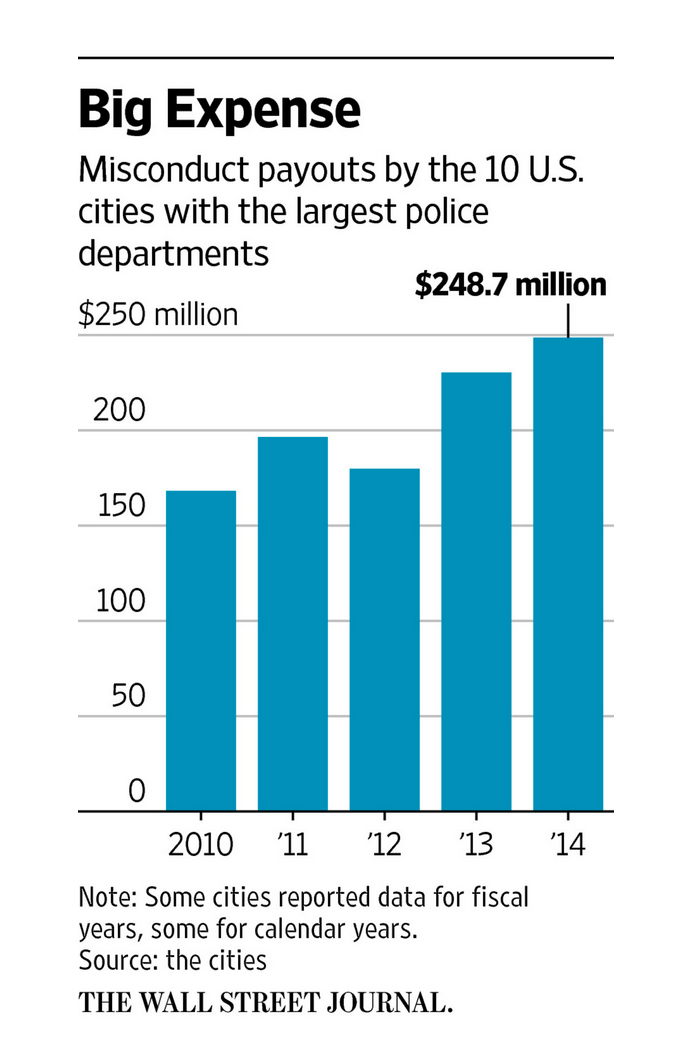Yes, I subscribe to the Wall Street Journal; or, rather, the Wall Street Journal dutifully appears on my doorstep every morning, gratis, because I teach economics at UC Berkeley. And today I read the headline: “Police-Misconduct Costs Soar” (http://on.wsj.com/1e1DEJf) and you just know that this article is not about the human costs of police misconduct. Its about the dollars and cents. But, here’s the rub. Why is it about “dollars and cents” when it begins to eat into my margins, but not about dollars and cents when, for pennies on the dollar, I could have decided (1) to increase funding for public schools; (2) implement single payer universal healthcare; (3) implement a living wage; and (4) attract investors back to high wage, labor intensive industries?
But that’s beside the point. The margin on private capital is everything. And the WSJ’s point is that municipalities are walking dangerously close to the margin when it comes to the costs of municipal policing.
The 10 cities with the largest police departments paid out $248.7 million last year in settlements and court judgments in police-misconduct cases, up 48% from $168.3 million in 2010, according to data gathered by The Wall Street Journal through public-records requests.
Those cities collectively paid out $1.02 billion over those five years in such cases, which include alleged beatings, shootings and wrongful imprisonment. When claims related to car collisions, property damage and other police incidents are included, the total rose to more than $1.4 billion.
And here’s what that looks like in WSJ blue and white:

At some point, these costs are going to require municipalities to float bonds to cover their increased liability. And so the metric would seem to be fairly straightforward: at what point do the costs of police misconduct outpace the costs of ensuring police compliance?
But, let us suppose that irrespective of the amount municipalities spend on police compliance, we instead consider litigation/settlement costs and compliance costs part of a single bundle of goods — let’s call them “security” goods. And let us further suppose that this bundle costs municipalities some measurable amount more than another bundle — let us call this other bundle “public” goods. In this alternative model, the amount a municipality spends on “public” goods more than covers the amounts it is projected to spend on “security” goods, up to a specific, determinable margin. (At this margin, no additional amount spent on public goods will diminish the costs of litigation/settlement/compliance.)
Although it is still prohibitively high, let us take fifty percent of the security bundle of 2010 as our equilibrium. That is to say, no matter how much we spend on public goods, security goods for these 10 municipalities will be $84M. Now let us suppose that our 10 municipalities infuse an additional $84M into their public goods markets — for schools, healthcare, living wage, and investment in manufacturing. In that case, the question would be whether our demand for security goods would decline by $84M, bringing the total costs back down to 2010 levels. Although we would need to run the numbers — I have pulled these out of my theoretical hat — I am reasonably confident that the current mix of security and public goods is inefficient (on the “beatings will continue until morale improves” assumption) and that every dollar spent on security goods is far less efficient than every dollar spent on public goods.
So, why is there not so much of a peep in the WSJ considering this alternative model? Let us suppose, for the moment, that we developed legislation under the assumption that every dollar spent on public goods was doubled by the benefits arising from a better educated, more skilled, healthier, and more productively occupied public. But let us also suppose that the only mechanism for increasing revenues spent on public goods was to increase tax rates on wealth. Finally, let us suppose that increasing these tax rates would decrease marginal returns on wealth in an amount equivalent to but not less than these tax revenues; a reasonable assumption since municipal taxation policy is overwhelmingly regressive. So, while it is true that a greater focus on public goods would significantly improve municipal budgets, it would also cut into the margins currently enjoyed by private capital.
Or, another way to put the same question would be: why might private capital not want a healthy, wealthy, wise, and secure public? You do the math.
